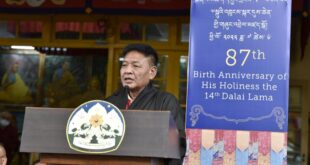By Abanti Bhattacharya
The Asia Times Online
Dec 16, 2011
Among other implications, the self-immolation of Tibetans in China overwhelmingly suggests the failure of minority policy carved out by the People’s Republic of China (PRC) to deal with the ethnic nationality question in the 1950s. The failure is particularly significant as it comes on the heels of the so called revised policy decision on Tibet in 2010 underscored in the Tibet Work Report that called for harmonious development in Tibet.
The Fifth National Conference on the Work of Tibet was held in Beijing in January 18-20, 2010, to deliberate on China’s policy direction on Tibet. It was quite evident that the conference took place after the March 2008 Tibetan uprising. The last conference was held in 2001. Notably, the Fifth Tibet Work Report differed from the Fourth Work Report in three aspects.

First, it focussed on developing the rural areas; second, it emphasized on economic well-being and providing social security network rather than on strategic infrastructure building; and third, it included all the Tibetan areas unlike the Fourth Work Report that was limited to the Tibetan Autonomous Region (TAR).
It is clear that the 2010 Tibet Work Conference was convened especially to consider post-Dalai Lama scenario. Therefore, President Hu Jintao identified Tibet a “special contradiction between people of all ethnic groups and the separatist forces led by the Dalai clique” and called for “leapfrog development” and “lasting stability” as primary aspects of the Tibet Work Conference.
Another crucial aspect of this conference was Hu’s emphasis on ensuring establishment of “a normal order of Tibetan Buddhism”. He did not elaborate what normal order meant but Beijing’s policies towards Tibet indicate China’s avowed policy to isolate the Dalai Lama and create an interpretation of Buddhism with Chinese characteristics as evident in the reincarnation law of 2007, the establishment of first-ever academy of Tibetan Buddhism in South-West China, and holding the World Buddhist Forum in Hangzhou in 2006.
Nonetheless, 11 cases of self-immolation primarily in Tibet since the 2010 conference indicate that the Work Report is fundamentally flawed. The broader reason of its failure is attributable to the minority policy, the essential component of which is the regional autonomy system.
Though inspired by the Soviet ethnic policy, regional autonomy system of the PRC deviated from the Russian federated state structure due to China’s bitter historical experience of an un-equal treaty system that reduced China into what Sun Yat-sen had called a “hypo-colony”.
In order to preserve China from dismemberment and reclaim sovereignty, the Chinese Communist Party (CCP) in the post-1949 period repudiated the right of self-determination envisaged in the Russian system and adopted Sun Yat-sen’s notion of “unity of five races”.
Further, 8.4 % of China’s minority occupying 63.7% of the mainland along the greater part of the border enhances China’s vulnerability. Therefore, sovereignty over Tibet is considered fundamental to China’s minority policy and is also the crux of Chinese nationalism.
To underscore the importance of China’s sovereignty over Tibet, in 2003, Hu delineated the “Three Insists”: adherence to socialism, the CCP leadership and regional autonomy for ethnic minorities. In July 2008, in a talk with the Tibetan Task Force Group,China reaffirmed its “Three Insists” principle and again, in January 2009, emphasizing China’s sovereignty over Tibet, the TAR legislature passed a resolution to celebrate March 28 as the Serf’s Emancipation Day.
Quite significantly, since China considers the status of Tibet as settled, the talks with the Tibetan Task Force is not about the question of Tibet” but about the future of the Dalai Lama and the people around him”. In fact, WikiLeaks revealed that for the Chinese leadership Tibet is even more sensitive than Taiwan. And that there is “absolutely no division” within the leadership on Tibet and hence there is unanimity on following essentially a hardline approach towards Tibet.
Thus far, the regional autonomy system was essentially crafted to enhance CCP’s sovereign control over Tibet. Politically, the first secretary of the TAR has always been a Han. The Tibetans have no real powers. In economic terms, the Westward Development Project unveiled in 2000 was essentially a security driven strategy combining five elements: hanization, resource extraction, infrastructure construction, military development and repression.
In essence, for China Tibet is a matter of sovereignty, not an issue of identity. The 2010 Work Report does not seek to address the core problem of identity of the Tibetans and hence the renewal of unrest and self-immolation in China.
In fact, the failure of Beijing’s Tibet policy also demonstrates that questions of identity cannot be resolved by flooding the region with money. In other words, the continuing unrest in Tibet raises questions on the success of Deng Xiaoping’s strategy of creating economic prosperity to mitigate separatism.
With regard to the self-immolation, evidently it started outside theTAR. This could be explained perhaps by the existence of more stringent and repressive policy in the TAR preventing such developments. More so, that the Dalai Lama was born in Amdo (present day part ofQinghaiprovince), not in the TAR provides the added inspiration for self-immolation in the region.
Further, contrary to most observations, self-immolation does not suggest growing frustration among the Tibetans. Rather, it indicates newer kinds of protest despite newer kinds of Beijing’s repressive measures. It does have strong emotional and demonstrative effect on the people globally. It is little wonder that it has spread to other Tibetan exiled-communities in Nepal and India.
Thus, it broadly demonstrates that the eleven cases of self-immolation by the Tibetans in Sichuan exposes the gaping limitations of Chinese nationalism that essentially seeks to submerge the sub-national identities into the greater Han nationality.
It is clear that so long as China treats the Tibetan nationality question as a strategic issue instead of an identity issue, that the Tibetan question will remain unresolved. In the post-Dalai Lama era, in the absence of the Dalai Lama the movement may lose its force and China may then be able to control the Tibetan movement through its repressive machinery but, the Tibetan identity will remain a burning issue in China’s foreign and domestic policy.
Abanti Bhattacharya is Associate Professor at the Department of East Asian Studies, University of Delhi, India.


